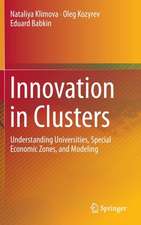Management of Software Engineering Innovation in Japan
Autor Yasuo Kadonoen Limba Engleză Paperback – 23 aug 2016
The author and his colleagues developed a structural model including innovational paths, such as service innovation, product innovation and process innovation, and a measurement model including the seven software engineering capabilities: deliverables, project management, quality assurance, process improvement, research and development, human resource development and customer contact. Then they designed research on software engineering excellence and administered it with the Japanese Ministry of Economy, Trade and Industry and Information-Technology Promotion Agency. Through statistical analyses of the results, they found that human resource development and R&D are significant fundamental conditions to improve the quality of the deliverables and that IT firms with high levels of deliverables, derived from high levels of human resource development, quality assurance, project management and process improvement, tend to sustain high profitability. In addition, they developed a measurement model based on Porter’s five forces and Barney’s resource-based view. A regression tree analysis suggested that manufacturer spin-off vendors tend to expand business with well-resourced R&D, whereas user spin-off vendors tend to depend heavily on parent company demand.
| Toate formatele și edițiile | Preț | Express |
|---|---|---|
| Paperback (1) | 381.98 lei 6-8 săpt. | |
| Springer – 23 aug 2016 | 381.98 lei 6-8 săpt. | |
| Hardback (1) | 370.88 lei 38-44 zile | |
| Springer – 23 oct 2015 | 370.88 lei 38-44 zile |
Preț: 381.98 lei
Nou
Puncte Express: 573
Preț estimativ în valută:
73.09€ • 76.52$ • 60.48£
73.09€ • 76.52$ • 60.48£
Carte tipărită la comandă
Livrare economică 05-19 aprilie
Preluare comenzi: 021 569.72.76
Specificații
ISBN-13: 9784431562948
ISBN-10: 443156294X
Pagini: 173
Ilustrații: XIII, 173 p.
Dimensiuni: 155 x 235 mm
Greutate: 0.27 kg
Ediția:Softcover reprint of the original 1st ed. 2015
Editura: Springer
Colecția Springer
Locul publicării:Tokyo, Japan
ISBN-10: 443156294X
Pagini: 173
Ilustrații: XIII, 173 p.
Dimensiuni: 155 x 235 mm
Greutate: 0.27 kg
Ediția:Softcover reprint of the original 1st ed. 2015
Editura: Springer
Colecția Springer
Locul publicării:Tokyo, Japan
Cuprins
Part I Industry and Engineering Capabilities from Surveys and Statistical Analyses.- 1.Introduction to Software Engineering Innovation in Japan.- 2. Surveys on Software Engineering Excellence.- 3. Statistical Analysis Results and Practical Implications of the SEE Surveys.- Part II Research Relevant to Managing Innovation in the Broadest Sense.- 4. A Study of the Characteristics of Software Vendors in Japan from a Competitive Environment and Resource-Based Viewpoint.- 5. IT Management Effectiveness: An Empirical Study in Japanese Companies.- 6. Social Research on IT Management Innovation Toward Service Science and Science for Society.- 7. Agent-Based Modeling of the Software Industry Structure in Japan: Preliminary Consideration of the Influence of Offshoring in China.- 8. Hybrid Methods to Predict Scenarios in the Japanese Software Industry.
Textul de pe ultima copertă
This book assesses the achievements of the software engineering discipline as represented by IT vendors in Japan in order to deepen understanding of the mechanisms of how software engineering capabilities relate to IT vendors’ business performance and business environment from the perspective of innovation and engineering management. Based on the concepts of service science and science for society, the volume suggests how to improve the sophistication of services between the demand side, i.e., IT user companies, and the supply side, i.e., IT vendors, simultaneously.
The author and his colleagues developed a structural model including innovational paths, such as service innovation, product innovation and process innovation, and a measurement model including the seven software engineering capabilities: deliverables, project management, quality assurance, process improvement, research and development, human resource development, and customer contact. Then they designed research on software engineering excellence and administered it with the Japanese Ministry of Economy, Trade and Industry and Information-Technology Promotion Agency. Through statistical analyses of the results, they found that human resource development and R&D are significant fundamental conditions to improve the quality of the deliverables and that IT firms with high levels of deliverables, derived from high levels of human resource development, quality assurance, project management and process improvement, tend to sustain high profitability. In addition, they developed a measurement model based on Porter’s five forces and Barney’s resource-based view. A regression tree analysis suggested that manufacturer spin-off vendors tend to expand business with well-resourced R&D, whereas user spin-off vendors tend to depend heavily on parent company demand.
The author and his colleagues developed a structural model including innovational paths, such as service innovation, product innovation and process innovation, and a measurement model including the seven software engineering capabilities: deliverables, project management, quality assurance, process improvement, research and development, human resource development, and customer contact. Then they designed research on software engineering excellence and administered it with the Japanese Ministry of Economy, Trade and Industry and Information-Technology Promotion Agency. Through statistical analyses of the results, they found that human resource development and R&D are significant fundamental conditions to improve the quality of the deliverables and that IT firms with high levels of deliverables, derived from high levels of human resource development, quality assurance, project management and process improvement, tend to sustain high profitability. In addition, they developed a measurement model based on Porter’s five forces and Barney’s resource-based view. A regression tree analysis suggested that manufacturer spin-off vendors tend to expand business with well-resourced R&D, whereas user spin-off vendors tend to depend heavily on parent company demand.
Caracteristici
Presents interdisciplinary work of social research, statistics and simulation on management of technology Provides a data-centric approach based on the large-scale social research and longitudinal financial data of major IT vendors in Japan Comprises a collaborative work with international researchers, business people, e.g., IT vendors and policy makers at the Ministry of Economy, Trade and Industry and Information-Technology Promotion Agency Includes supplementary material: sn.pub/extras

























